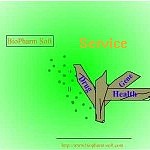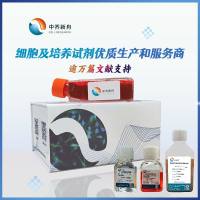【共享】 小书一本,生物芯片数据分析
丁香园论坛
714
刚才在网上看到的,不知道是不是有人发过了。
网址:http://www.csc.fi/oppaat/siru/
下载地址:http://www.csc.fi/oppaat/siru/siruwww.pdf
分部分下载地址:
Part I
http://www.csc.fi/oppaat/siru/sirupartI.pdf
PartII
http://www.csc.fi/oppaat/siru/sirupartII.pdf
PartIII
http://www.csc.fi/oppaat/siru/sirupartIII.pdf
PartIV
http://www.csc.fi/oppaat/siru/sirupartIV.pdf
简介
DNA Microarray Data Analysis
A guidebook for DNA Microarray Data Analysis
This guidebook was a collaboration between several Finnish researchers from different universities and research institutions. The first edition of the DNA microarray data analysis guidebook was written by M. Minna Laine (chapters 4, 8 and 14), Tomi Pasanen (chapter 11), Janna Saarela (chapters 2 and 3), Ilana Saarikko (chapter 8), Teemu Toivanen (chapter 14), Martti Tolvanen (chapter 12), Jarno Tuimala (chapters 4, 6, 7, 8, 9, 10, 13 and 15), Mauno Vihinen (chapters 10, 11 and 12), and Garry Wong (chapters 1 and 5).
The purpose of this book is to serve as course and teaching material to introduce basic concepts of microarray data analysis. We hope that especially researchers starting their data analysis can benefit from the book.
Each chapter has a section on suggested reading, which introduces some of the relevant literature. Several chapters also include data analysis examples using GeneSpring software.
We are very interested in receiving feedback about this publication. Please email your comments about this book to Jarno Tuimala.
Copyright
CSC - the Finnish IT center for science, is a non-profit organization for high-performance computing and networking in Finland. CSC is owned by the Ministry of Education. CSC provides cross-disciplinary expertise, computational resources and fast network connections for computational science and engineering.
All rights reserved by CSC - Scientific Computing Ltd., Finland. The PDF version of this book or parts of it can be used for academic non-profit purposes, provided that this copyright notice is included. This publication may not be sold or included as part of other publications without permission of CSC.
Table of contents
Part I Introduction
1 Introduction
1.1 Why perform microarray experiments?
1.2 What is a microarray?
1.3 Microarray production
1.4 Where can I obtain microarrays?
1.5 Extracting and labeling the RNA sample
1.6 RNA extraction from scarse tissue samples
1.7 Hybridization
1.8 Scanning
1.9 Typical research applications of microarrays
1.10 Experimental design and controls
1.11 Suggested reading
2 Affymetrix Genechip system
2.1 Affymetrix technology
2.2 Single Array analysis
2.3 Detection p-value
2.4 Detection call
2.5 Signal algorithm
2.6 Analysis tips
2.7 Comparison analysis
2.8 Normalization
2.9 Change p-value
2.10 Change call
2.11 Signal Log Ratio Algorithm
3 Genotyping systems
3.1 Introduction
3.2 Methodologies
3.3 Genotype calls
3.4 Suggested reading
4 Overview of data analysis
4.1 cDNA microarray data analysis
4.2 Affymetrix data analysis
4.3 Data analysis pipeline
5 Experimental design
5.1 Why do we need to consider experimental design?
5.2 Choosing and using controls
5.3 Choosing and using replicates
5.4 Choosing a technology platform
5.5 Gene clustering v. gene classification
5.6 Conclusions
5.7 Suggested reading
6 Basic statistics
6.1 Why statistics are needed
6.2 Basic concepts
6.3 Simple statistics
6.4 Effect statistics
6.5 Frequency distributions
6.6 Transformation
6.7 Outliers
6.8 Missing values and imputation
6.9 Statistical testing
6.10 Analysis of variance
6.11 Statistics using GeneSpring
6.12 Suggested reading
Part II Analysis
7 Preprocessing of data
7.1 Rationale for preprocessing
7.2 Missing values
7.3 Checking the background reading
7.4 Calculation of expression change
7.5 Handling of replicates
7.6 Checking the quality of replicates
7.7 Outliers
7.8 Filtering bad data
7.9 Filtering uninteresting data
7.10 Simple statistics
7.11 Skewness and normality
7.12 Spatial effects
7.13 Normalization
7.14 Similarity of dynamic range, mean and variance
7.15 Examples using GeneSpring
7.16 Suggested reading
8 Normalization
8.1 What is normalization?
8.2 Sources of systematic bias
8.3 Normalization terminology
8.4 Performing normalization
8.5 Mathematical calculations
8.6 Some caution is needed
8.7 Graphical example
8.8 Example of calculations
8.9 Using GeneSpring for normalization
8.10 Suggested reading
9 Finding differentially expressed genes
9.1 Identifying over- and underexpressed genes
9.2 What about the confidence?
9.3 GeneSpring examples
9.4 Suggested reading
10 Cluster analysis of microarray information
10.1 Basic concept of clustering
10.2 Principles of clustering
10.3 Hierarchical clustering
10.4 Self-organizing map
10.5 K-means clustering
10.6 Principal component analysis
10.7 Pros and cons of clustering
10.8 Visualization
10.9 Programs for clustering and visualization
10.10 Function prediction
10.11 GeneSpring and clustering
10.12 Suggested reading
Part III Data mining
11 Gene regulatory networks
11.1 What are gene regulatory networks?
11.2 Fundamentals
11.3 Bayesian network
11.4 Calculating Bayesian network parameters
11.5 Searching Bayesian network structure
11.6 Conclusion
11.7 Suggested reading
12 Data mining for promoter sequences
12.1 Introduction
12.2 Introduction
12.3 Finding promoter region sequences
12.4 Using EnsMart to retrieve promoter regions
12.5 Comparison of EnsMart and UCSC searches
12.6 Pattern search without prior knowledge
12.7 Summary
12.8 GeneSpring and promoter analysis
12.9 Suggested reading
13 Annotations and article mining
13.1 Retrieving annotations from public databases
13.2 Retrieving annotations using BLAST
13.3 Article mining
13.4 Annotation and gene ontologies using GeneSpring
Part IV Tools and data management
14 Reporting results
14.1 Why the results should be reported
14.2 What details should be reported: the MIAME standard
14.3 How the data should be presented: the MAGE standard
14.4 Where and how to submit your data
14.5 MIAME-compliant sample attributes in GeneSpring
14.6 Suggested reading
15 Software issues
15.1 Data format conversions problems
15.2 A standard file format
15.3 Programming
15.4 Freeware software packages
Index

网址:http://www.csc.fi/oppaat/siru/
下载地址:http://www.csc.fi/oppaat/siru/siruwww.pdf
分部分下载地址:
Part I
http://www.csc.fi/oppaat/siru/sirupartI.pdf
PartII
http://www.csc.fi/oppaat/siru/sirupartII.pdf
PartIII
http://www.csc.fi/oppaat/siru/sirupartIII.pdf
PartIV
http://www.csc.fi/oppaat/siru/sirupartIV.pdf
简介
DNA Microarray Data Analysis
A guidebook for DNA Microarray Data Analysis
This guidebook was a collaboration between several Finnish researchers from different universities and research institutions. The first edition of the DNA microarray data analysis guidebook was written by M. Minna Laine (chapters 4, 8 and 14), Tomi Pasanen (chapter 11), Janna Saarela (chapters 2 and 3), Ilana Saarikko (chapter 8), Teemu Toivanen (chapter 14), Martti Tolvanen (chapter 12), Jarno Tuimala (chapters 4, 6, 7, 8, 9, 10, 13 and 15), Mauno Vihinen (chapters 10, 11 and 12), and Garry Wong (chapters 1 and 5).
The purpose of this book is to serve as course and teaching material to introduce basic concepts of microarray data analysis. We hope that especially researchers starting their data analysis can benefit from the book.
Each chapter has a section on suggested reading, which introduces some of the relevant literature. Several chapters also include data analysis examples using GeneSpring software.
We are very interested in receiving feedback about this publication. Please email your comments about this book to Jarno Tuimala.
Copyright
CSC - the Finnish IT center for science, is a non-profit organization for high-performance computing and networking in Finland. CSC is owned by the Ministry of Education. CSC provides cross-disciplinary expertise, computational resources and fast network connections for computational science and engineering.
All rights reserved by CSC - Scientific Computing Ltd., Finland. The PDF version of this book or parts of it can be used for academic non-profit purposes, provided that this copyright notice is included. This publication may not be sold or included as part of other publications without permission of CSC.
Table of contents
Part I Introduction
1 Introduction
1.1 Why perform microarray experiments?
1.2 What is a microarray?
1.3 Microarray production
1.4 Where can I obtain microarrays?
1.5 Extracting and labeling the RNA sample
1.6 RNA extraction from scarse tissue samples
1.7 Hybridization
1.8 Scanning
1.9 Typical research applications of microarrays
1.10 Experimental design and controls
1.11 Suggested reading
2 Affymetrix Genechip system
2.1 Affymetrix technology
2.2 Single Array analysis
2.3 Detection p-value
2.4 Detection call
2.5 Signal algorithm
2.6 Analysis tips
2.7 Comparison analysis
2.8 Normalization
2.9 Change p-value
2.10 Change call
2.11 Signal Log Ratio Algorithm
3 Genotyping systems
3.1 Introduction
3.2 Methodologies
3.3 Genotype calls
3.4 Suggested reading
4 Overview of data analysis
4.1 cDNA microarray data analysis
4.2 Affymetrix data analysis
4.3 Data analysis pipeline
5 Experimental design
5.1 Why do we need to consider experimental design?
5.2 Choosing and using controls
5.3 Choosing and using replicates
5.4 Choosing a technology platform
5.5 Gene clustering v. gene classification
5.6 Conclusions
5.7 Suggested reading
6 Basic statistics
6.1 Why statistics are needed
6.2 Basic concepts
6.3 Simple statistics
6.4 Effect statistics
6.5 Frequency distributions
6.6 Transformation
6.7 Outliers
6.8 Missing values and imputation
6.9 Statistical testing
6.10 Analysis of variance
6.11 Statistics using GeneSpring
6.12 Suggested reading
Part II Analysis
7 Preprocessing of data
7.1 Rationale for preprocessing
7.2 Missing values
7.3 Checking the background reading
7.4 Calculation of expression change
7.5 Handling of replicates
7.6 Checking the quality of replicates
7.7 Outliers
7.8 Filtering bad data
7.9 Filtering uninteresting data
7.10 Simple statistics
7.11 Skewness and normality
7.12 Spatial effects
7.13 Normalization
7.14 Similarity of dynamic range, mean and variance
7.15 Examples using GeneSpring
7.16 Suggested reading
8 Normalization
8.1 What is normalization?
8.2 Sources of systematic bias
8.3 Normalization terminology
8.4 Performing normalization
8.5 Mathematical calculations
8.6 Some caution is needed
8.7 Graphical example
8.8 Example of calculations
8.9 Using GeneSpring for normalization
8.10 Suggested reading
9 Finding differentially expressed genes
9.1 Identifying over- and underexpressed genes
9.2 What about the confidence?
9.3 GeneSpring examples
9.4 Suggested reading
10 Cluster analysis of microarray information
10.1 Basic concept of clustering
10.2 Principles of clustering
10.3 Hierarchical clustering
10.4 Self-organizing map
10.5 K-means clustering
10.6 Principal component analysis
10.7 Pros and cons of clustering
10.8 Visualization
10.9 Programs for clustering and visualization
10.10 Function prediction
10.11 GeneSpring and clustering
10.12 Suggested reading
Part III Data mining
11 Gene regulatory networks
11.1 What are gene regulatory networks?
11.2 Fundamentals
11.3 Bayesian network
11.4 Calculating Bayesian network parameters
11.5 Searching Bayesian network structure
11.6 Conclusion
11.7 Suggested reading
12 Data mining for promoter sequences
12.1 Introduction
12.2 Introduction
12.3 Finding promoter region sequences
12.4 Using EnsMart to retrieve promoter regions
12.5 Comparison of EnsMart and UCSC searches
12.6 Pattern search without prior knowledge
12.7 Summary
12.8 GeneSpring and promoter analysis
12.9 Suggested reading
13 Annotations and article mining
13.1 Retrieving annotations from public databases
13.2 Retrieving annotations using BLAST
13.3 Article mining
13.4 Annotation and gene ontologies using GeneSpring
Part IV Tools and data management
14 Reporting results
14.1 Why the results should be reported
14.2 What details should be reported: the MIAME standard
14.3 How the data should be presented: the MAGE standard
14.4 Where and how to submit your data
14.5 MIAME-compliant sample attributes in GeneSpring
14.6 Suggested reading
15 Software issues
15.1 Data format conversions problems
15.2 A standard file format
15.3 Programming
15.4 Freeware software packages
Index











